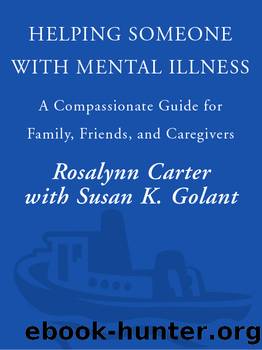Helping Someone with Mental Illness by Rosalynn Carter

Author:Rosalynn Carter [Carter, Rosalynn]
Language: eng
Format: epub
ISBN: 978-0-307-80725-0
Publisher: Potter/Ten Speed/Harmony/Rodale
Published: 2011-09-28T00:00:00+00:00
Scientists continue to make great progress in the recognition and treatment of anxiety disorders. The most important thing for people suffering from these disorders to know is that they have a serious but treatable problem. They need to know, too, that they are not alone, that their condition is not trivial, and that, with appropriate care, they can expect to lead normal, productive lives.
Part III
Interventions: Preventive,
Personal, and Public
Websterâs New World Dictionary defines intervention as âthe act of interveningâcoming between as in order to modify, settle or hinder some action.â Certainly, we would like to intervene to control mental illnesses, to modify the toll they take on individuals and their families, and eventually to hinder or prevent them.
Today there are exciting possibilities for these interventions. The growth in knowledge about mental illnesses in recent years has significantly increased our understanding of how and why they occur. This, as we have seen, has led to new treatments that better control the illnesses and lessen their severity. It has also allowed us to determine more fully the risks that contribute to their development, and although scientists are not yet in a position to specify definitive strategies, there is enough information to point out some opportunities for preventive intervention.
At our tenth annual mental health symposium at The Carter Center, âChildren and Families at Risk,â we focused on risk factors that contribute to the onset of mental illness and interventions that reduce these factors and promote mental health, particularly in children.
Dr. William Beardslee, acting chairman of the Department of Psychiatry at Childrenâs Hospital of Boston and professor of child psychiatry at Harvard Medical School, reminded us that historically, a focus on prevention has been neglected, although a good deal of work has been done in the past ten years. From a scientific point of view, the study of prevention involves following, over extended periods, large samples of individuals who are at risk of developing mental disorders. Prevention involves considering what will happen, for instance, three, five, ten, and fifteen years or more down the line. It does not focus on short-term outcomes or what is demonstrable in a single year.
Our society has a difficult time thinking about the future over the long term and in making commitments to follow through with programs. This has contributed to the lack of serious efforts designed to prevent long-term mental health problems.
The Institute of Medicine of the National Academy of Sciences recently examined a series of risk factors for major disorders, including depression. In depression, for instance, the risks range from having a relative who had the disorder (suggesting some kind of genetic cause) to being subjected to severe stressâa loss, divorce, separation, unemployment, or some other traumatic experience. Fifteen years ago, we did not understand the powerful effects that violence and living in poverty have on later mental disorders, including depression. Now we have some sense of these.
As Dr. Beardslee points out, âIn trying to understand a ⦠disorderâs cause and prevention, we are immersed in a sea of social factors (i.
Download
This site does not store any files on its server. We only index and link to content provided by other sites. Please contact the content providers to delete copyright contents if any and email us, we'll remove relevant links or contents immediately.
Rewire Your Anxious Brain by Catherine M. Pittman(17605)
Talking to Strangers by Malcolm Gladwell(11920)
The Art of Thinking Clearly by Rolf Dobelli(8878)
Mindhunter: Inside the FBI's Elite Serial Crime Unit by John E. Douglas & Mark Olshaker(7855)
Becoming Supernatural by Dr. Joe Dispenza(7126)
Change Your Questions, Change Your Life by Marilee Adams(6668)
The Road Less Traveled by M. Scott Peck(6657)
Nudge - Improving Decisions about Health, Wealth, and Happiness by Thaler Sunstein(6648)
The Lost Art of Listening by Michael P. Nichols(6492)
Enlightenment Now: The Case for Reason, Science, Humanism, and Progress by Steven Pinker(6420)
Win Bigly by Scott Adams(6330)
Mastermind: How to Think Like Sherlock Holmes by Maria Konnikova(6260)
The Way of Zen by Alan W. Watts(5814)
Daring Greatly by Brene Brown(5667)
Grit by Angela Duckworth(4752)
Big Magic: Creative Living Beyond Fear by Elizabeth Gilbert(4741)
Men In Love by Nancy Friday(4351)
Flow by Mihaly Csikszentmihalyi(4070)
The Four Tendencies by Gretchen Rubin(4035)
